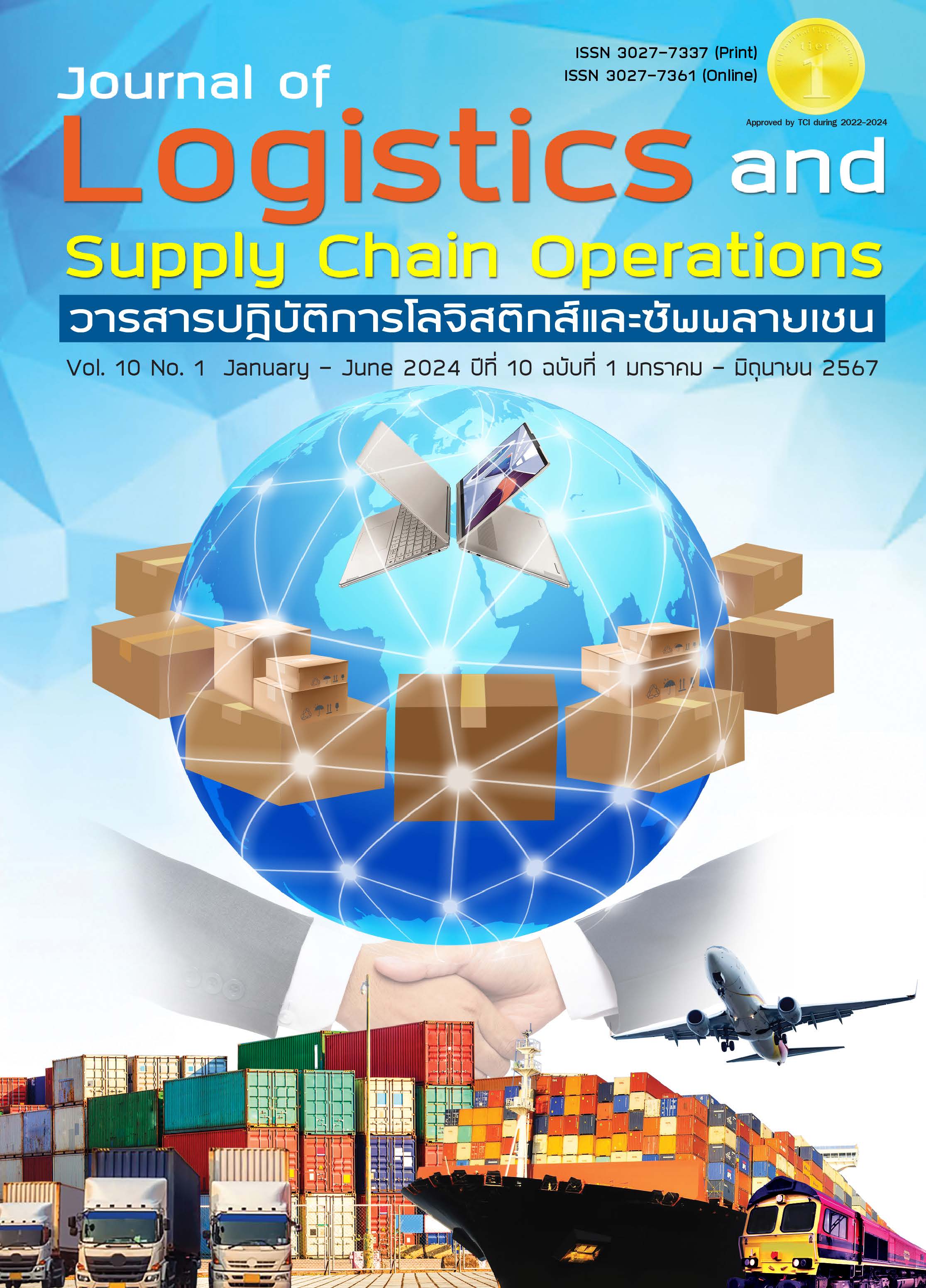Risks of the Export Process of a Company Exporting Wood-Substitute Composites in Thailand during the Covid-19 Pandemic
DOI:
https://doi.org/10.53848/jlscc.v10i1.264860Keywords:
Export process, Failure mode and effect analysis, Logistics, RiskAbstract
The objectives of this research were to study core working activities for exporting wood-substitute composites during COVID-19 in a company, to analyze possible risks and to propose guidelines for prevention. This research was qualitative and applied research, specifically to study for the company. The data collection was done through in-depth interview and focus group brainstorming, with 10 interviewees possessing characteristics as predeterminants and being specifically selected from 37 candidates working in the company concerning exporting. Questions were open-ended, consistent with the research framework and were reviewed by three experts. The IOC values were between 0.67 and 1.00. Data analysis was the inductive method and was reviewed by the triangulation approach. The results showed that the company had nine core working activities in the export process and a total 29 failures were found. All failures were analyzed by the Risk Priority Number, ranging from 2 to 125. The most common was that no space was available for exporting, resulting from lockdown and the entry-exit prohibition of destinations. From the selection of the top 10 RPNs to propose solutions against the risks and small-scale implementation for two months, it was found that the associated RPNs could decrease by over 50%.
References
กรมศุลกากร. (2562). พิธีการศุลกากรส่งของออก. ค้นเมื่อ 20 กุมภาพันธ์ 2565, จาก: https://www.customs.go.th.
กรมเจรจาการค้าระหว่างประเทศ. (2564). สถานการณ์การส่งออกเฟอร์นิเจอร์และชิ้นส่วนของไทยปี 2563. ค้นเมื่อ 26 พฤศจิกายน 2565, จาก: https://www.dtn.go.th.
กระทรวงพาณิชย์. (2566). สถิติการค้าระหว่างประเทศของไทย ปี 2535 – 2565 (มกราคม - พฤศจิกายน). ค้นเมื่อ 26 พฤศจิกายน 2565, จาก: https://tradereport.moc.go.th.
ขวัญชัย เจริญกรุง, นภาลัย เสมอใจ, วรรษชล เพ็งแย้ม, ปรียากรณ์ กล้าใจ และนฤชา จากปล้อง. (2558). การศึกษาเปรียบเทียบประสิทธิภาพของวัสดุทดแทนไม้ จากวัสดุชีวภาพต่อการเข้าทำลายของปลวกใต้ดิน. ค้นเมื่อ 2 มกราคม 2566, จาก: http://forprod.forest.go.th/forprod/frs-research.
ลงทุนแมน. (2565). ผลิตภัณฑ์ไม้ สินค้าส่งออกของไทยที่กำลังเติบโต. ค้นเมื่อ 2 มกราคม 2566, จาก: https://www.longtunman.com/36108.
สถาบันวิจัยเพื่อการพัฒนาประเทศไทย. (2564). ปัญหาค่าขนส่งทางเรือสูงในช่วงโควิด-19. ค้นเมื่อ 26 พฤศจิกายน 2565, จาก: https://www.tdri.or.th/2021/04/covid-111/.
สมภพ ตลับแก้ว. (2551). การประยุกต์ใช้วิธีการ FMEA เพื่อปรับปรุงความพึงพอใจของลูกค้า. พัฒนาเทคนิคศึกษา, 21(68), 24-29.
สุภาวดี คุ้มราษฎร์. (2560). การขนส่งสินค้าระหว่างประเทศ และการเลือกตัวแทนขนส่งสินค้า: มุมมองผู้ส่งออก. วารสารธุรกิจปริทัศน์, 9(2), 215-230.
สำนักงานสภาพัฒนาการเศรษฐกิจและสังคมแห่งชาติ. (2564). รายงานภาวะเศรษฐกิจ ในประเทศ ปี 2564. ค้นเมื่อ 26 พฤศจิกายน 2565, จาก: https://www.nesdc.go.th.
อรสุรางค์ หวังวิศวาวิทย์. (2559). การวิเคราะห์ความเสี่ยงของกระบวนการนำเข้าสินค้าด้วยเทคนิค FMEA.การค้นคว้าอิสระปริญญามหาบัณฑิต สาขาการจัดการโลจิสติกส์, มหาวิทยาลัยเทคโนโลยีพระจอมเกล้าธนบุรี.
Aleksander, S., & Maria, C. (2018). Failure Mode and Effect Analysis of Air Cargo Freight Services Provider. Logistics and Transport, 2(38), 69-76.
Emre, A., & Erkan, C. (2018). A Quantitative Risk Analysis by Using Interval Type-2 Fuzzy FMEA Approach: the Case of Oil Spill. Maritime Policy & Management, 45(8), 979-994.
Hoseynabadi, H.A., Oraee, H., & Tavner, P.J. (2010). Failure Modes and Effect Analysis (FMEA) for Wind Turbines. Electrical Power and Energy Systems, 32(7), 817-824.
Lavastre, O., Gunasekaran, A., & Spalanzani, A. (2012). Supply Chain Risk Management in French Companies. Decision Support Systems, 52(4), 828-838.
Mcdermott, R.E., Mikulak, R.J. & Beauregard, M.R. (2008). The Basics of FMEA (2nd edition). New York: Productivity Press.
Sayareh, J., & Ahouei, V.R. (2013). Failure Mode and Effects Analysis (FMEA) for Reducing the Delays of Cargo Handling Operations in Marine Bulk Terminals. Journal of Maritime Research, 10(2), 43-50.



